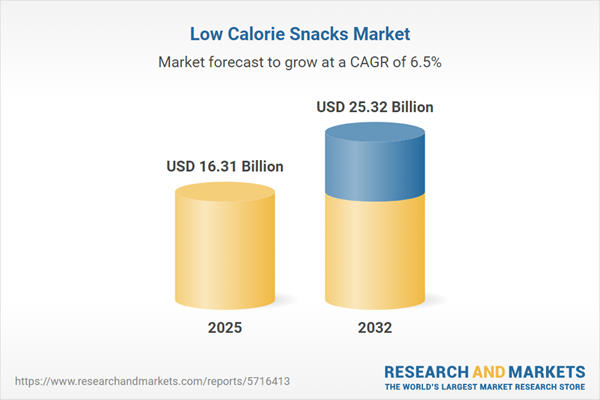Speak directly to the analyst to clarify any post sales queries you may have.
The low calorie snacks market presents a dynamic landscape requiring responsive strategies from senior decision-makers. As this sector continues to transform, robust market intelligence is essential for navigating regulatory demands, changing consumer needs, and intensifying competition.
Market Snapshot: Low Calorie Snacks Market Overview
The low calorie snacks market is on an upward trajectory, achieving a compound annual growth rate (CAGR) of 6.48% between 2024 and 2025. During this period, the market's value increased from USD 15.31 billion to USD 16.31 billion. Growth is underpinned by a decisive shift among consumers toward accessible and healthier snacking options. Retailers are moving swiftly to online channels, expediting product launches and diversifying offerings. Established brands leverage targeted wellness initiatives and continuous innovation to carve out a competitive edge. These elements reinforce the necessity for companies to emphasize agile planning, consumer focus, and rigorous compliance monitoring in a rapidly evolving industry.
Scope & Segmentation in the Low Calorie Snacks Market
Comprehensive segmentation of the low calorie snacks market enables precise benchmarking and opportunity recognition. By understanding the breadth of product types, distribution strategies, and end user needs, leaders are empowered to make informed allocation and targeting choices in every segment.
- Product Types: Includes granola bars, protein bars, nutrition bars, chips, cookies, crackers, whole grain-based snacks, nut and seed products, cheese, and butter popcorn. Expanding these categories allows for alignment with diverse dietary preferences and the rising demand for functionally enhanced snacks.
- Distribution Channels: Encompasses convenience stores, drug stores, supermarkets, hypermarkets, and e-commerce. Diversifying across channels supports robust omnichannel strategies and helps track shifts in consumer access and buying habits.
- Packaging Types: Encompasses bulk packs, multi-unit, and single-serve formats. Understanding these options assists in meeting expectations for portion control, freshness, and sustainable practices.
- Sweetener Types: Consists of artificial sweeteners, natural alternatives, and sugar alcohols. Each offers unique considerations for product acceptance and requires careful regulatory and technical management.
- Applications: Covers wellness, sports nutrition, and weight management. Focused innovation here supports differentiated strategies for specific consumer health objectives.
- End Users: Includes foodservice operators, institutional purchasers, and retail businesses. Insights into these groups foster effective targeting and efficient supply chain management.
- Geographies: Segmentation across the Americas, EMEA, and Asia-Pacific highlights the need for regional adaptation and attention to regulatory and consumer variations.
- Key Companies: Focus on leading brands such as PepsiCo, Mondelēz International, Nestlé, Kellogg Company, General Mills, Mars, Hershey Company, Conagra Brands, Campbell Soup Company, and Grupo Bimbo. Their initiatives drive change and set industry standards.
Key Takeaways for Senior Decision-Makers
- Broaden product offerings by introducing plant-based proteins, whole grains, and vegetable-derived ingredients, reflecting evolving health and nutrition trends.
- Enhance labeling transparency by limiting artificial additives to reinforce consumer trust and meet compliance standards.
- Adopt a multi-channel distribution approach by expanding online, subscription, and in-store presence to meet changing purchase behaviors.
- Invest in eco-friendly packaging to align with growing sustainability requirements and consumer environmental awareness.
- Leverage advanced technologies and develop agile operations, enabling fast adaptation to shifting regulations and market disruptions.
- Tailor sourcing strategies and product flavors to suit local regulatory frameworks and taste preferences, boosting resilience against supply uncertainties and improving regional relevance.
Tariff Impact on Supply Chains and Pricing
Recent hikes in US tariffs affecting critical snack ingredients and packaging are redefining supply chain operations within the low calorie snacks market. Companies are responding by enlarging supplier networks, emphasizing domestic and tariff-exempt sourcing, and refining cost management approaches. These strategies help ensure stable supply continuity and reliable pricing, critical for procurement teams navigating evolving trade regulations and maintaining competitive performance.
Methodology & Data Sources
This analysis synthesizes insights from executive interviews, expert nutritional perspectives, trade data evaluation, business record review, and proprietary internal research. Findings are validated by external experts, enhancing their practical relevance for strategic business planning.
Why This Report Matters for Senior Decision-Makers
- Presents detailed segmentation to optimize investment decisions and sharpen strategic focus across all low calorie snacks industry sub-sectors.
- Equips commercial teams to forecast and adapt to ongoing consumer and compliance shifts, building business resilience.
- Drives continuous improvement in product development and supply chain efficiency, strengthening prospects for long-term success.
Conclusion
Tailored segmentation and actionable insights empower leadership to anticipate shifts, maintain competitiveness, and foster sustainable growth in the rapidly evolving low calorie snacks space.
Additional Product Information:
- Purchase of this report includes 1 year online access with quarterly updates.
- This report can be updated on request. Please contact our Customer Experience team using the Ask a Question widget on our website.
Table of Contents
3. Executive Summary
4. Market Overview
7. Cumulative Impact of Artificial Intelligence 2025
Companies Mentioned
The companies profiled in this Low Calorie Snacks market report include:- PepsiCo, Inc.
- Mondelēz International, Inc.
- Nestlé S.A.
- Kellogg Company
- General Mills, Inc.
- Mars, Incorporated
- The Hershey Company
- Conagra Brands, Inc.
- Campbell Soup Company
- Grupo Bimbo, S.A.B. de C.V.
Table Information
| Report Attribute | Details |
|---|---|
| No. of Pages | 181 |
| Published | October 2025 |
| Forecast Period | 2025 - 2032 |
| Estimated Market Value ( USD | $ 16.31 Billion |
| Forecasted Market Value ( USD | $ 25.32 Billion |
| Compound Annual Growth Rate | 6.4% |
| Regions Covered | Global |
| No. of Companies Mentioned | 11 |









